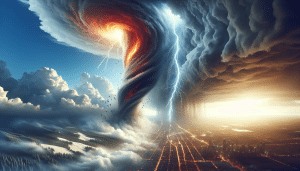Why Extreme Weather News Captures Global Attention
Emily Clarke September 28, 2025
Explore how news about extreme weather events impacts global communities and drives public action. This in-depth guide reveals how such reporting shapes risk perception, preparedness, and conversations about climate change amid rapidly shifting conditions.
Why Extreme Weather Events Dominate Headlines
Extreme weather events—like hurricanes, record-breaking heatwaves, and devastating floods—frequently command front-page coverage. It’s no surprise; these stories immediately affect millions and have long-term consequences well beyond the initial moments of crisis. Newsrooms prioritize these phenomena because the stakes are high. The combination of drama, unpredictability, and real-time updates ensures such headlines remain a focus for viewers, readers, and listeners. When a tornado rips through a town or wildfire smoke drifts over cities, the public is immediately drawn in by both human interest and the essential information shared. The collective urge to understand what’s happening next drives site traffic and media buzz even as communities scramble to respond.
There’s an added urgency around news on extreme weather because of the way technology enables rapid dissemination of warnings and images. Social media now amplifies a single local event to the entire globe in minutes. Images of submerged highways, collapsed roofs, or volunteers rescuing neighbors create visceral connections that transcend geographical boundaries. Coverage goes beyond facts; it often tells stories of resilience, loss, and hope. The human dimension keeps people engaged, motivated to help, or compelled to take precautions for their own safety. In many cases, reports from trusted sources shape public understanding about how to prepare, where to seek help, and what to expect from the unpredictable nature of the climate.
Major outlets also highlight how climate change is accelerating both the frequency and intensity of these occurrences. The framing of these news cycles has evolved to include deep dives into scientific projections, expert commentary, and community response strategies. Audiences now expect not only updates but also context that links current conditions to broader environmental changes. This integration of science communication into breaking news boosts awareness and initiates important conversations about sustainability, adaptation, and resilience. Extreme weather coverage—far from being sensational—serves a vital public role in informing, educating, and protecting the global population.
How Reporting Shapes Public Risk Perception
Media coverage is a powerful shaper of risk perception. Studies suggest that attention to severe weather stories, especially those rich with detailed information and strong visuals, causes individuals to reassess their vulnerability and behaviors. When people see extensive, expert-backed coverage—complete with meteorologists’ warnings and first-hand accounts—they feel the immediacy of the danger. For some, this means double-checking insurance, updating emergency plans, or reviewing regional evacuation maps. For others, it sparks conversations with family about preparedness. The effect is more than psychological; local governments report surges in community engagement and requests for information after high-impact news events.
There’s also a social dimension to risk perception. When communities see their neighbors featured in the news as survivors or responders, a sense of shared responsibility emerges. Peer groups may share preparedness tips, distribute checklists, or volunteer for mutual aid projects. Civic organizations coordinate responses, sometimes in partnership with local news media or public agencies. Reliable news about extreme weather doesn’t just warn; it mobilizes. This effect is especially pronounced in areas repeatedly affected by similar hazards, where collective memory and communal storytelling sustain preparedness long after the storm itself has passed.
The evolution of risk perception through repeated news exposure means that even in distant regions, people pay more attention to warnings and adapt their behavior. For example, as hurricanes become more frequent topics in national media, landlocked populations may start to consider flood insurance or invest in backup generators, prompted by stories of survivors elsewhere. The overall impact is clear: responsible journalism about weather extremes helps bridge the gap between knowledge and action, reducing harm and increasing resilience at every level of society.
Role of Live Updates and Satellite Data in Modern Reporting
Advances in technology have transformed how journalists and the public follow extreme weather. The availability of live satellite data and interactive maps through digital media bring real-time clarity to complex situations, allowing for precise tracking of storms, atmospheric rivers, or wildfire plumes. These tools don’t just improve reporting speed—they make information more actionable for audiences. Mobile alerts, geo-targeted warnings, and data visualizations move people beyond speculation. Readers not only learn what’s happening but see for themselves where critical threats are moving, sometimes down to their own street.
Major news organizations often partner with weather services, universities, and government agencies to bring the best insights to viewers. For instance, during hurricanes, reporters use radar imagery and predictive models to guide evacuation timing and route planning. In wildfire season, real-time satellite data overlays can show compromised air quality and shifting fire lines in seconds. This integration of public data with journalism means that each alert reflects current reality rather than archived statistics or anecdotal estimation. Access to these tools enhances trust and prevents rumors or misinformation from derailing public preparedness.
This technological leap has also lowered barriers to entry for hyperlocal reporting. Community media and citizen journalists can now access official datasets directly, offering granular updates for neighborhoods underserved by national outlets. When someone on the ground corroborates events with official weather center feeds, accuracy improves and panic is reduced. In short, the democratization of real-time data equips everyone—from professional editors to regular residents—to become informed, proactive participants in their communities’ response to severe weather.
Extreme Weather’s Influence on Politics and Policy Discussions
Coverage of major weather disasters often shapes more than just daily routines; it affects politics and public policy. Elected officials respond to urgent demands for action, turning media attention into legislative debates on emergency funding, infrastructure upgrades, or disaster relief. Major news stories can catalyze bipartisan support for FEMA response, global climate accords, or resilience investments that might otherwise stall in quieter news cycles. When severe flooding or drought dominates coverage, lawmakers are faced with constituent pressure to prioritize solutions and accountability.
Issue salience is a key media effect. When a hurricane is top-of-mind thanks to graphic and persistent news coverage, government agencies are incentivized to coordinate regionally and deploy public messaging about risks. Editorials and expert interviews introduce evidence-based recommendations, fostering transparency and dialogue. As more extreme weather events occur, there’s heightened scrutiny on preparedness budgets, adaptation plans, and long-term infrastructure resilience. This increased visibility can drive change in everything from local town planning to national energy strategy.
Citizen involvement increases when news stories offer clear reporting on both immediate impacts and systemic solutions. Readers and viewers become stakeholders, engaging with nonprofit initiatives, offering public comments on zoning proposals, and supporting grassroots advocacy. Ultimately, the news cycle can transform a local emergency into a national moment of reckoning, pushing forward both policy shifts and public conversation long after the skies clear. Extreme weather reporting is thus a powerful lever for collective action and societal change.
From Local Impact to Global Conversation: The Ripple Effect
When extreme weather hits, its effects often travel far beyond the geographic zone initially affected. Supply chains, regional economies, and public health systems can all feel the aftershocks. News coverage serves as a bridge, explaining these ripple effects to global audiences. For instance, drought in one country may impact food prices worldwide, or wildfires in another region can affect air travel and respiratory health across continents. By elevating these stories, media outlets connect the dots for readers, showcasing the interconnectedness of modern society and the environment.
Discussion of these broader consequences helps people understand that there are shared risks and collective responsibilities. Scientists and policy experts are often interviewed to provide insight into how changes in one area affect global climate patterns, trade, or migration. This reporting answers the public’s curiosity about why their local supermarket shelves might look different, or why insurance premiums have changed. It also drives home the idea that individual and community actions—such as emission reductions or disaster preparedness—have cumulative effects on worldwide outcomes.
The global news ecosystem amplifies lessons learned from one disaster to communities everywhere. Relief organizations adapt their strategies based on media reports of what succeeded or failed elsewhere. Urban planners share best practices using case studies highlighted in in-depth journalism. In sum, reporting on the far-reaching outcomes of local disasters fuels ongoing innovation and adaptive strategies around the world. Extreme weather coverage is no longer just about the storm; it’s about forging a smarter, more connected, and resilient global community ready to weather what comes next.
References
1. National Weather Service. (n.d.). Weather News & Resources. Retrieved from https://www.weather.gov/news
2. United Nations Office for Disaster Risk Reduction. (n.d.). Why Disaster News Matters. Retrieved from https://www.undrr.org/news
3. Pew Research Center. (2022). News Consumption and Extreme Weather. Retrieved from https://www.pewresearch.org/science/2022/11/23/news-consumption-and-extreme-weather/
4. World Meteorological Organization. (n.d.). Climate and Extreme Events. Retrieved from https://public.wmo.int/en/events/extreme-weather
5. U.S. Global Change Research Program. (n.d.). Weather, Risk and Resilience. Retrieved from https://www.globalchange.gov/climate-change-health/extreme-weather
6. National Aeronautics and Space Administration. (n.d.). Real-time Satellite Data in Disaster Reporting. Retrieved from https://earthdata.nasa.gov/learn/toolkits/disasters







